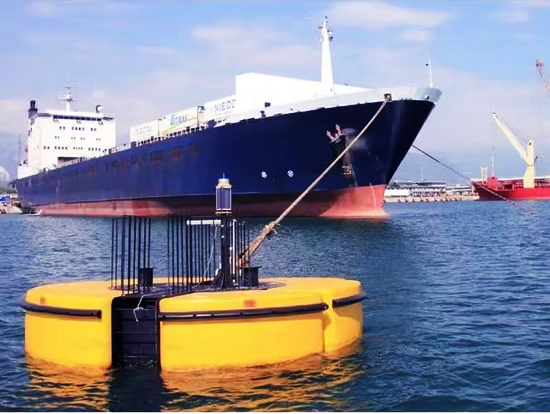1. What Is a Mooring Buoy?
When you’re out on the water, whether in a busy harbor or an open anchorage, a mooring buoy serves as your vessel’s safe haven. These floating devices secure ships without requiring dock space, making them a crucial part of maritime operations. In this guide, we’ll explore what a mooring buoy is, its purpose, how it works, and why it’s so important for both commercial and recreational use.

2. Understanding the Mooring Buoy: A Quick Overview
A mooring buoy floats on the water’s surface and attaches to the seabed. Unlike traditional dock mooring, where a ship ties directly to a pier, the buoy provides a floating point for ships to secure themselves. Vessels connect to the buoy using mooring lines or chains, ensuring they stay in place, even in unpredictable waters.
These buoys use durable materials like reinforced plastic, steel, or rubber to endure harsh marine conditions.
3. The Purpose of a Mooring Buoy
A mooring buoy plays a key role in keeping a vessel securely anchored. Here’s why you need one:
- Secure Your Vessel: Mooring buoys help keep boats stationary and prevent them from drifting, even in rough seas.
- Protect Your Vessel: By anchoring the boat securely, the buoy minimizes the risk of damage from collisions with docks or other vessels.
- Save Dock Space: Mooring buoys allow you to use docking space efficiently by providing a reliable anchoring option that requires less space than traditional dock mooring.
- Weather Protection: Mooring buoys keep your vessel stable during storms or gusty winds, reducing the risks posed by adverse weather conditions.
4. Different Types of Mooring Buoys for Various Needs
Mooring buoys aren’t one-size-fits-all. The type of buoy you need depends on the size of your vessel, the environment, and your specific needs. Here’s a quick breakdown:
- Single-Point Mooring Buoys: These are the most common. They work well for smaller vessels or calm waters. You can easily attach your vessel to a single point.
- Multi-Point Mooring Buoys: For larger ships or stronger currents, multi-point systems use multiple buoys and anchor points for added stability.
- Special Purpose Mooring Buoys: Offshore oil rigs, floating platforms, and heavy-duty vessels require stronger, specialized mooring buoys built to withstand more extreme conditions.
5. How a Mooring Buoy Works
Here’s how a mooring buoy functions: You attach the buoy to an anchor or chain anchored to the seabed. When a vessel approaches, it connects to the buoy using a mooring line or chain. This keeps the boat stationary while protecting the vessel and the dock from damage.
Mooring buoys absorb the force of waves, currents, and wind, providing a stable position for your ship and reducing unwanted movement.
6. Advantages of Using a Mooring Buoy
Using a mooring buoy offers multiple benefits:
- Convenience: Mooring buoys make it quick and easy to secure your vessel without needing complex dock infrastructure. You can dock efficiently and safely with minimal effort.
- Safety: Mooring buoys protect your vessel from drifting and help you avoid collisions with other ships or obstacles.
- Lower Maintenance: Since the buoy absorbs impact, it minimizes wear and tear on your vessel and dock, extending their lifespan.
- Protection in All Conditions: Whether docking in a busy port or enduring rough weather, a mooring buoy keeps your vessel secure in any situation.
7. Mooring Buoys in Action
You’ll find mooring buoys used in various settings:
- Ports and Harbors: In busy commercial ports, buoys help vessels dock efficiently without occupying valuable pier space.
- Offshore Operations: Offshore oil rigs and floating platforms rely on mooring buoys to secure vessels in open seas.
- Recreational Boating: Private marinas and recreational boating areas use mooring buoys to provide boaters with secure, easy docking options.
8. Choosing the Right Mooring Buoy
When selecting a mooring buoy, keep these factors in mind:
- Vessel Size and Weight: Larger vessels need stronger, more durable mooring buoys. Choose a buoy designed to handle your ship’s size and weight.
- Environmental Conditions: Consider the sea conditions. In areas with strong currents or rough weather, you’ll need a sturdier buoy system.
- Maintenance Needs: Choose a buoy that’s easy to maintain and built to last, especially in challenging marine environments.
9. Conclusion
A mooring buoy plays a vital role in maritime safety, whether you’re docking in a busy harbor or anchoring in open waters. These buoys help protect your vessel, save dock space, and make docking more efficient. With the right mooring buoy, you can ensure a smooth, secure docking process every time.
At Sunhelm Marine, we specialize in providing high-quality mooring buoys designed to meet your specific needs and ensure the safety of your vessel in any environment.
10. FAQ Section
- What’s the difference between a mooring buoy and an anchor?
A mooring buoy provides a floating point for vessels to secure themselves, while an anchor holds a ship in place by attaching directly to the seabed. - Can I use a mooring buoy in bad weather?
Yes, mooring buoys are specifically designed to withstand rough seas, strong winds, and varying tides, keeping your vessel secure in all conditions. - How do mooring buoys protect my vessel?
By providing a secure, stable anchoring point, mooring buoys prevent vessels from drifting into other ships or obstacles, reducing the risk of collisions and damage.


